Throughout history, snakes and humans haven’t always gotten along. In fact, the fear of snakes is so common that there’s a word for it: Ophidiophobia. Forests and rivers all around the world harbor serpents of jaw-dropping sizes, some of which have displayed aggressive behavior and inspired local legends of man-eating monsters.
Just how large can some of the heftiest types of snakes get? Today we’ll be looking at 10 of the largest snakes in the world, and learning a little bit about each of the different species. These truly massive snake species will be an ophidiophobiac’s greatest nightmare!
-
Papuan Olive Python – (Apodora papuana)
Weight: 50 lb.
Length: 14.4 ft
Location: New Guinea
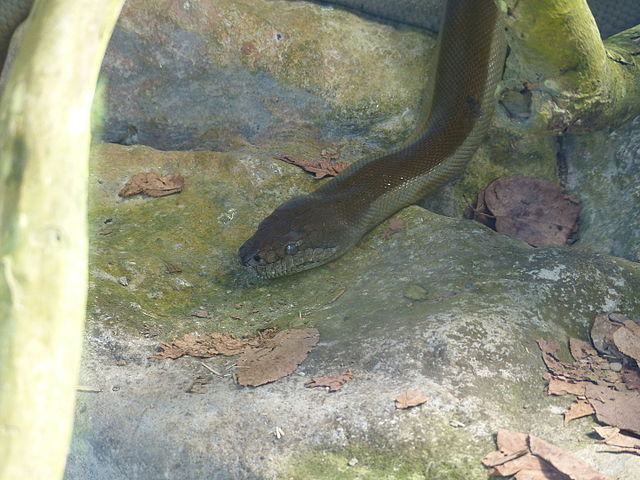
Source: wikipedia.org
This gorgeous python has a distinctive skin that shifts between light and dark olive or brown shades according to the lighting. While their diet mainly consists of small mammals, Papuan Olive Pythons have also been observed eating other snakes as well.
Did You Know?
While most people would find these snakes to be intimidating if encountered in the wild, they are known for being surprisingly mild-mannered and docile, even when handled.
-
Cuban Boa – (Chilabothrus angulifer)
Weight: 60 lb.
Length: 16 ft
Location: Cuba

Source: wikipedia.org
Also known as the Cuban Tree Boa due to its tendency to climb and rest in the canopy, this snake is considered to be endangered. This species is unique among snakes in that it has been known to frequently hunt in groups. Cuban Tree Boas have been documented waiting in strategic positions at cave openings to snatch bats that exit.
Did You Know?
Part of the cause for the endangered status of the Cuban Boa is the threat that it poses to people’s livestock. Farmers are known to kill them on sight as a preventative measure.
-
Boa Constrictor – (Boa constrictor)
Weight: 99 lb.
Length: 14 ft
Location: Central and South America

Source: wikipedia.org
This huge snake has distinct, saddle-shaped markings down its back and can sport a variety of different markings on its head. Boa constrictors also possess plenty of sharp, backwards-curving teeth that are perfect for snagging prey. Once its meal is caught, the strong snake will wrap tightly around its prey and constrict until it suffocates.
Did You Know?
Boa constrictors have little claws known as pelvic spurs, which are actually believed to be the evolutionary remnants of what were once hind legs.
-
Yellow Anaconda – (Eunectes notaeus)
Weight: 120 lb.
Length: 15.5 ft
Location: South America
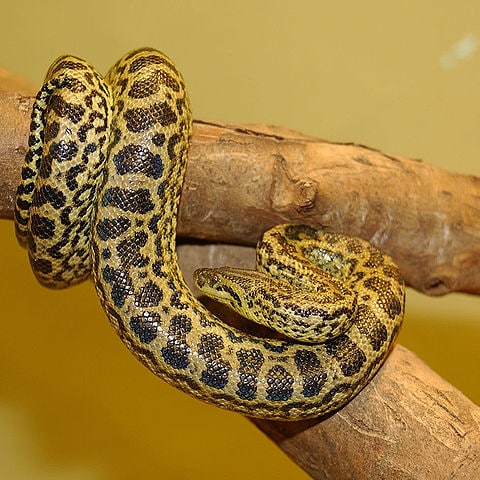
Source: wikipedia.org
This strikingly-colorful reptile is highly aquatic, primarily inhabiting marshes, swamps, and riverbanks–even the courtship and mating process takes place in the water. When Yellow Anacondas venture into the forest, they generally do so on a hunt for large game such as deer and peccaries.
Did You Know?
The female Yellow Anacondas are generally larger than the males, and incubate their eggs internally in order to give birth to live young.
-
Indian Python – (Python molurus)
Weight: 200 lb.
Length: 21 ft
Location: Southern Asia
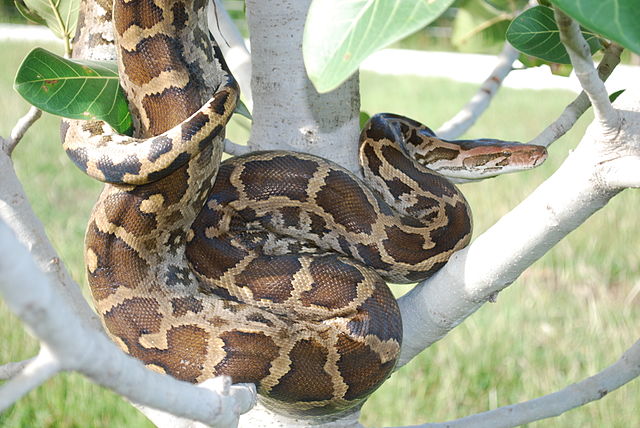
Source: wikipedia.org
Especially common in India, Sri Lanka, and the East Indies, this impressive constrictor often tends to grow larger in Indian jungles than it does in other areas. The habitat of the Indian Python varies greatly, including everything from grasslands and foothills to forests and swamps.
Did You Know?
Unfortunately, these huge snakes are still hunted for their skins, and over-hunting can reduce the population to dangerously low numbers that threaten to throw off the local ecosystems.
-
Amethystine (Scrub) Python – (Morelia amethistina)
Weight: 200 lb.
Length: 26 ft
Location: Australia
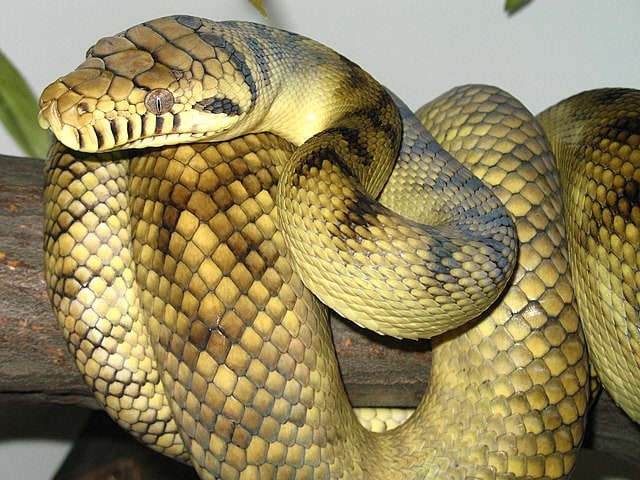
Source: wikipedia.org
In addition to its primary locations in Australia, the beautiful Amethystine Python can be found in New Guinea as well. This impressive snake is known for its reclusive attitude and irritability when disturbed, and is named for the striking blue shimmer that its skin displays in certain lighting.
Did You Know?
Smaller specimens of the Amethystine Python inhabit trees and higher places, while the larger specimens often take to rivers and other bodies of water.
-
African Rock Python – (Python sebae)
Weight: 250 lb.
Length: 25 ft
Location: Africa
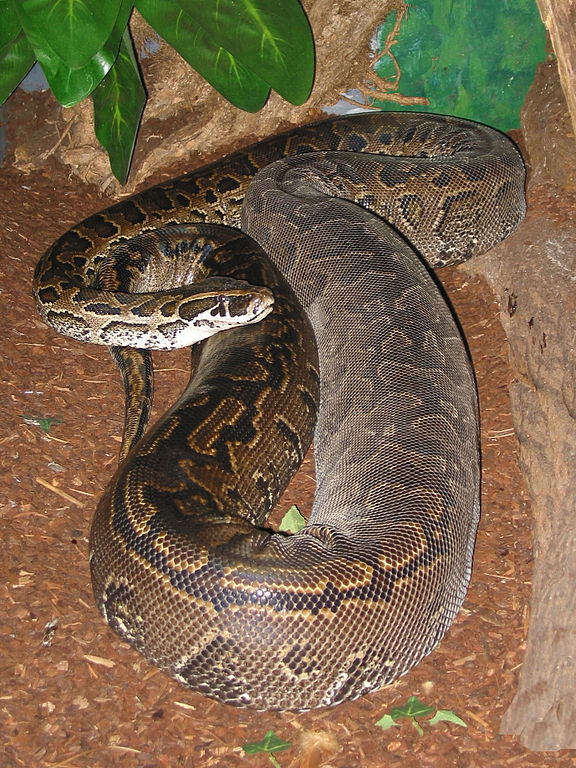
Source: wikipedia.org
Said to be the largest species of snake in Africa, this impressive reptile is most active during the wet seasons and often lies dormant when the weather is dry. The African Rock Python has a grim reputation because of its intimidating size, but there are few accounts of attacks on humans.
Did You Know?
Female African Rock Pythons can lay up to 100 eggs, and have a reputation for being aggressively defensive of their broods.
-
Reticulated Python – (Python reticulatus)
Weight: 350 lb.
Length: 33 ft
Location: Southeast Asia

Source: wikipedia.org
The Reticulated Python kills its prey by ambushing and constricting it, and has been known to occasionally forage for food as well. Like many other large snakes, Reticulated Pythons have a very low metabolic rate and can sustain for long periods of time between meals.
Did You Know?
Reticulated Pythons are predominantly nocturnal, often retiring to caves or crevices to digest their latest meal and wait out the daylight.
-
Burmese Python – (Python bivittatus)
Weight: 403 lb.
Length: 18.8 ft
Location: Southeast Asia

Source: wikipedia.org
This massive member of the python family is very active, and is known to shift habitats during its lifespan. Young Burmese Pythons spend most of their time lurking in the trees. However, when they grow to adulthood and get too large and heavy to climb as easily, they spend more time on the ground and in the water.
Did You Know?
Burmese pythons do not have venomous bites, which may contribute to their popularity among exotic pet enthusiasts.
-
Green Anaconda – (Eunectes murinus)
Weight: 550 lb.
Length: 30 ft
Location: South America
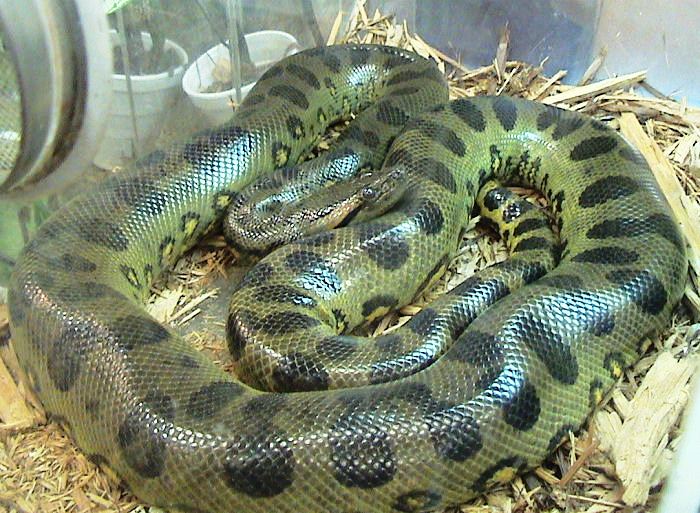
Source: wikipedia.org
The Green Anaconda is the largest snake in the world by mass. This astounding serpent is also one of the longest snakes in the world, and can reach a hefty girth of up to 12 inches in diameter. These magnificent snakes have a special place in South American mythology, often being depicted as magical beings with shape-shifting or healing abilities.
Did You Know?
Many local legends and tall tales have claimed that the Green Anaconda can reach staggering lengths of 40-60 feet–however, these claims remain unverified and are likely exaggerated.
